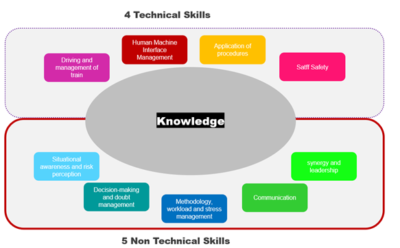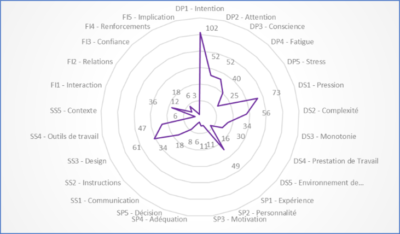What are the key HOF issues? In 2020, SNCF became a unified public group composed by several anonymous companies. Given the status change, it was important to provide a common and unique definition of Safety Culture...
HOF regulations, standards and tools
About this topic
Introduction
The systematic integration of HOF cannot be done without having a consistent reference base in the form of regulations, standards and tools. This basis makes it possible to develop the integration of HOF in the Safety Management System (SMS). This common reference allows for standardisation of HOF both within and between companies. Indeed, the systematic integration of HOF into the European railway sector at the end of the twentieth century and the beginning of the twenty-first century was not a priority for all. It was necessary to develop a common vision, common definition and tools which allowed the sector to build a common understanding of HOF.
Relevance to rail
The sector already developed a certain number of standards, such as those on ergonomic design for example. A second step happened with the emergence of generic management standards (ISO 9000, OHSAS 18000 and ISO 45000) and the second European railway package (2004). Influenced by these regulations and standards, companies have developed their management systems with risk management gradually becoming the basis of their SMS .
At that time some did not hesitate to say that 80% of the causes of accidents are human error. A more systematic analysis of accidents and the growing interest in HOF led many to go beyond this simplification and to determine the organizational and human influencing factors. Inspired by developments in different sectors such as nuclear, aerospace, petrochemicals… regulations and standards evolve and integrate the (organizational and) human factors within their frameworks.
This normative framework served as an inspiration for the development of the European Union rail regulatory framework published in 2016 (4th Railway Package) where integration of HOF in the SMS is now mandatory.
The continual development of ergonomic tools, regulations and standards make this HOF integration approach a consistent one.
Non-technical skills for the train driver’s job – SNCF Voyageurs
What are the key HOF issues? With the influx of HOF specialists in 2008, the Traction Department (SNCF Voyageurs) has undertaken in-depth work to develop the non-technical skills of train drivers. Our work was based on...
Integration of 5×5 model in Infrabel
What are the key HOF issues? When we are talking about a "Human Factors" approach, generally we are positively received at the beginning. First, there is curiosity, a desire to know quite more about this new point of...
ISO/TR 16982:2002 Ergonomics of human-system interaction — Usability methods supporting human-centred design.
https://www.iso.org/standard/31176.html
ISO/TS 18152:2010 Ergonomics of human-system interaction — Specification for the process assessment of human-system issues
https://www.iso.org/standard/56174.html
ISO 9241 – 220:2019 Ergonomics of human-system interaction: Processes for enabling, executing and assessing human-centred design within organizations
https://www.iso.org/standard/63462.html
ISO 9241 – 210:2019 Ergonomics of human-system interaction: Human-centred design for interactive systems
https://www.iso.org/standard/77520.html
Reason, 2000. Human error: models and management. British Medical Journal, 320, 768-770
https://www.bmj.com/content/320/7237/768?ath_user=efschouston002&ath_ttok=%3CTPEEDaMygDfSrj8WwQ%3E
Hawkins, 1993. Human factors in flight. England: Avebury Technical.
HSE guidance: Introduction to human factors
https://www.hse.gov.uk/humanfactors/introduction.htm#:~:text=A%20Human%20Factors%20(or%20Ergonomics,better%20managed%2C%20more%20effective%20organisation.
RSSB Standards Catalogue
https://www.rssb.co.uk/standards-catalogue
Official website of the EU Agency for Railways (ERA)
https://www.era.europa.eu/
Official website of the International Organization for Standardization (ISO)
https://www.iso.org/home.html
Official website of the International Union of Railway – UIC
https://uic.org/
Official website of the European Union
https://op.europa.eu/en/home
Accou, B. and Carpinelli, F. (2022) “Systematically investigating human and organisational factors in complex socio-technical systems by using the “SAfety FRactal ANalysis” method” Applied Ergonomics Volume 100
Abstract: In order to manage the performance of socio-technical systems in a safe and sustainable way, the importance of looking at human and organisational factors (HOF) and their contribution to adverse events is...
ERA – Human and Organisational Factors (HOF)
ERA - Activities - Safety Management System - Human and Organisational Factors (HOF)
Directive 2016/798 on railway safety that imposes to railway undertakings and infrastructure managers to integrate human and organisational factors in their safety management system
Directive 2016/798 on railway safety that imposes to railway undertakings and infrastructure managers to integrate human and organisational factors in their safety management system
Directive 89/391 on the introduction of measures to encourage improvements in the safety and health of workers at work
Directive 89/391 on the introduction of measures to encourage improvements in the safety and health of workers at work
Co-construction of a Safety Culture model at SNCF
What are the key HOF issues? In 2020, SNCF became a unified public group composed by several anonymous companies. Given the status change, it was important to provide a common and unique definition of Safety Culture for the entire SNCF group. By...

Non-technical skills for the train driver’s job – SNCF Voyageurs
What are the key HOF issues? With the influx of HOF specialists in 2008, the Traction Department (SNCF Voyageurs) has undertaken in-depth work to develop the non-technical skills of train drivers. Our work was based on the scientific definition of...

Integration of 5×5 model in Infrabel
What are the key HOF issues? When we are talking about a "Human Factors" approach, generally we are positively received at the beginning. First, there is curiosity, a desire to know quite more about this new point of view. In a second time, our...
ISO/TR 16982:2002 Ergonomics of human-system interaction — Usability methods supporting human-centred design.
https://www.iso.org/standard/31176.html
ISO/TS 18152:2010 Ergonomics of human-system interaction — Specification for the process assessment of human-system issues
https://www.iso.org/standard/56174.html
ISO 9241 – 220:2019 Ergonomics of human-system interaction: Processes for enabling, executing and assessing human-centred design within organizations
https://www.iso.org/standard/63462.html
ISO 9241 – 210:2019 Ergonomics of human-system interaction: Human-centred design for interactive systems
https://www.iso.org/standard/77520.html
Reason, 2000. Human error: models and management. British Medical Journal, 320, 768-770
https://www.bmj.com/content/320/7237/768?ath_user=efschouston002&ath_ttok=%3CTPEEDaMygDfSrj8WwQ%3E
Hawkins, 1993. Human factors in flight. England: Avebury Technical.
HSE guidance: Introduction to human factors
https://www.hse.gov.uk/humanfactors/introduction.htm#:~:text=A%20Human%20Factors%20(or%20Ergonomics,better%20managed%2C%20more%20effective%20organisation.
RSSB Standards Catalogue
https://www.rssb.co.uk/standards-catalogue
Official website of the EU Agency for Railways (ERA)
https://www.era.europa.eu/
Official website of the International Organization for Standardization (ISO)
https://www.iso.org/home.html
Official website of the International Union of Railway – UIC
https://uic.org/
Official website of the European Union
https://op.europa.eu/en/home
Accou, B. and Carpinelli, F. (2022) “Systematically investigating human and organisational factors in complex socio-technical systems by using the “SAfety FRactal ANalysis” method” Applied Ergonomics Volume 100
Abstract: In order to manage the performance of socio-technical systems in a safe and sustainable way, the importance of looking at human and organisational factors (HOF) and their contribution to adverse events is widely recognised. In reality,...
ERA – Human and Organisational Factors (HOF)
ERA - Activities - Safety Management System - Human and Organisational Factors (HOF)
Directive 2016/798 on railway safety that imposes to railway undertakings and infrastructure managers to integrate human and organisational factors in their safety management system
Directive 2016/798 on railway safety that imposes to railway undertakings and infrastructure managers to integrate human and organisational factors in their safety management system
Directive 89/391 on the introduction of measures to encourage improvements in the safety and health of workers at work
Directive 89/391 on the introduction of measures to encourage improvements in the safety and health of workers at work
Co-construction of a Safety Culture model at SNCF
What are the key HOF issues? In 2020, SNCF became a unified public group composed by several anonymous companies. Given the status change, it was important to provide a common and unique definition of Safety Culture for the entire SNCF group. By...

Non-technical skills for the train driver’s job – SNCF Voyageurs
What are the key HOF issues? With the influx of HOF specialists in 2008, the Traction Department (SNCF Voyageurs) has undertaken in-depth work to develop the non-technical skills of train drivers. Our work was based on the scientific definition of...

Integration of 5×5 model in Infrabel
What are the key HOF issues? When we are talking about a "Human Factors" approach, generally we are positively received at the beginning. First, there is curiosity, a desire to know quite more about this new point of view. In a second time, our...
ISO/TR 16982:2002 Ergonomics of human-system interaction — Usability methods supporting human-centred design.
https://www.iso.org/standard/31176.html
ISO/TS 18152:2010 Ergonomics of human-system interaction — Specification for the process assessment of human-system issues
https://www.iso.org/standard/56174.html
ISO 9241 – 220:2019 Ergonomics of human-system interaction: Processes for enabling, executing and assessing human-centred design within organizations
https://www.iso.org/standard/63462.html
ISO 9241 – 210:2019 Ergonomics of human-system interaction: Human-centred design for interactive systems
https://www.iso.org/standard/77520.html
Reason, 2000. Human error: models and management. British Medical Journal, 320, 768-770
https://www.bmj.com/content/320/7237/768?ath_user=efschouston002&ath_ttok=%3CTPEEDaMygDfSrj8WwQ%3E
Hawkins, 1993. Human factors in flight. England: Avebury Technical.
HSE guidance: Introduction to human factors
https://www.hse.gov.uk/humanfactors/introduction.htm#:~:text=A%20Human%20Factors%20(or%20Ergonomics,better%20managed%2C%20more%20effective%20organisation.
RSSB Standards Catalogue
https://www.rssb.co.uk/standards-catalogue
Official website of the EU Agency for Railways (ERA)
https://www.era.europa.eu/
Official website of the International Organization for Standardization (ISO)
https://www.iso.org/home.html
Official website of the International Union of Railway – UIC
https://uic.org/
Official website of the European Union
https://op.europa.eu/en/home
Accou, B. and Carpinelli, F. (2022) “Systematically investigating human and organisational factors in complex socio-technical systems by using the “SAfety FRactal ANalysis” method” Applied Ergonomics Volume 100
Abstract: In order to manage the performance of socio-technical systems in a safe and sustainable way, the importance of looking at human and organisational factors (HOF) and their contribution to adverse events is widely recognised. In reality,...
ERA – Human and Organisational Factors (HOF)
ERA - Activities - Safety Management System - Human and Organisational Factors (HOF)
Directive 2016/798 on railway safety that imposes to railway undertakings and infrastructure managers to integrate human and organisational factors in their safety management system
Directive 2016/798 on railway safety that imposes to railway undertakings and infrastructure managers to integrate human and organisational factors in their safety management system
Directive 89/391 on the introduction of measures to encourage improvements in the safety and health of workers at work
Directive 89/391 on the introduction of measures to encourage improvements in the safety and health of workers at work
Join us
Are you interested in HOF?
Do you want to learn about Human & Organisational Factors? Safety culture, non-technical skills, health and safety, more?
Join us on this international and diverse network which captures in one place the valuable and enriching information and material, either academic or practical railways-oriented, on the organizational and human factors that you need.
Are you involved in HOF activities?
You want to learn about Human & Organisational Factors? Safety culture, non-technical skills, health and safety, more?
Join us on this international and transversal network which capitalizes the valuable and enriching information and material, either academic nor Railways oriented, on the organizational and human factors that you need.
Are you an HOF expert?
Are you a Rail Human and Organisational factors expert, a Rail Safety expert, a Railway Head of safety, or other? This space is made for you. Here, you have access to confidential information and can even create or participate in a discussion forum to initiate conversations and exchanges with your peers.
